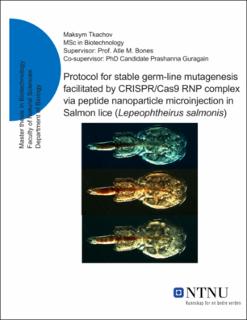| dc.description.abstract | Aquaculture is a rising economical industry since its inception, that is positioned as sustainable and reliable food source for continuously expanding human population. Salmon farming produces nutrition rich in omega−3 and omega−6 fatty acids, vital components of human diet that considerably increases income in countries where salmon is farmed. As in agriculture, the cultivated product is prone to infestations that rapidly spread in densely populated environment. Salmon lice (Lepeophtheirus salmonis), a parasite flourishing on salmon, is one of the major threats to the industry that does not have a complete solution. In order to expand understating of the problem modern technologies such as CRISPR should be applied to study gene functions based on loss of function experiments. Current approach of CRISPR delivery in marine organisms is based solely on embryonic microinjection and represents complexity for small organisms and laboratories where necessary equipment is absent. Here Cas9 protein, known as CRISPR was applied in combination with branched amphiphilic peptide nanocapsules in attempt to establish a laboratory protocol for germline knock-out experiments. In presented study 70 individuals both male and female lice in pre-adult stage were injected with Cas9/BAPC solution for germline knock-out, 20 were injected for somatic knock-out. BAPC delivery vector has not shown any mutation on target site in combination of GFP labelled Cas9 RNP complexes. Drawbacks of presented approach and alternative vectors are discussed within report with outline of future perspectives of CRISPR technology in Salmon lice. | |
